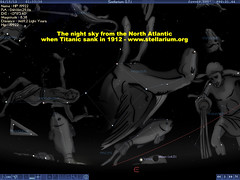I was excited to learn about the amazing, free and powerful planetarium software program Stellarium this week, and have taken some time to play with it a bit since. This morning with one of our science professors, we used it to discover exactly where the moon was the morning of April 15, 1912 when the Titanic sank.
According to this timeline of Titanic from HistoryOnTheNet, at 2:05 am the morning of April 15, 1912, the last lifeboat left the ship. The screenshot captured here shows the view looking east from the middle of the North Atlantic, and you can see a thin crescent moon rising. The exact date/time of this simulated view is shown in the upper left corner: we chose 1:30 am, about a half hour before the last lifeboat left the ship. Stellarium also lets you put the sky in motion, so you can see how the moon rose and the stars moved as the Titanic survivors waited for rescue. That rescue arrived a little after 4:00 am. I can hardly imagine how dark it must have been out there on the open ocean, and what a tragically emotional event that must have been, to listen to the voices of the freezing and dying as the night’s sky was above in all its splendor– sans any sort of light pollution what-so-ever.
Apparently James Cameron, director of the movie “Titanic,” got this wrong in the movie when he depicted the actual location and phase of the moon. The planet Venus was also visible, very close to the moon.
Stellarium is an AMAZING program, and it is free! Potential uses of Stellarium are only limited by our imaginations. I can’t wait to go stargazing with my family now, armed with my laptop and Stellarium– it can show live locations of all sorts of stars, planets, constellations, etc. A thorough, 81 page user guide (in PDF) is available from the Stallarium website.
If you enjoyed this post and found it useful, subscribe to Wes’ free newsletter. Check out Wes’ video tutorial library, “Playing with Media.” Information about more ways to learn with Dr. Wesley Fryer are available on wesfryer.com/after.
On this day..
- Storychasing Live Events: A Guide – 2023
- Orientation Challenge in MinecraftEDU – 2014
- Block Text Messages / SMS Spam and Phone Calls on Your iPhone – 2012
- NCLB has killed creative teaching and energetic learning about science (at least before state testing) – 2010
- #ISTE2010 Constructivist Celebration and The Imagine It! Project – 2010
- How We’re Reinventing the Blog by Sachin Agarwal (Posterous co-founder) – 2010
- Storychasers is looking for a new logo via @crowdspring – 2010
- Setup a new WordPress installation as a subdomain with Buddypress – 2010
- Internet Safety Issues: What can librarians do? – 2008
- Internet Crimes with Larry Boggess of OSBI – 2008


Comments
5 responses to “The moon the night Titanic sank”
Very cool. Easy to install and intuitive to use. I am going to send this on to my colleagues at ESC Region 15, and to our planetarium director here at ASU.
My daughter and I were looking at stars the other night, and I had been meaning to print out a map to assist us. This is great!
Glad you are enthused about this as well, Patrick! I am just amazed at the high quality and power of many open source software projects like this. I love it!
Wes,
Thank you for sharing-what an awesome resource! I shared Stellarium with some colleagues, my wife, and daughter today. My (4 year old) daughter eagerly inquired, “Do you have this on CD? Could you put that on my computer?”
After a few minutes of perusing Stellarium, her comment was, “It (Stellarium) is like Google Earth, only for the sky.”
I wish we had these resources at our fingertips (literally) when I was a child.
Glad you and others are finding Stellarium exciting and worthwhile, David! In terms of being alive to discovery and new learning, the good news is we can always be like children and never grow up! I have a feeling the amount of innovation and information sharing we are going to continue seeing in the years ahead is going to just blow our minds… We may not have had these tools as kids ourselves, but we’ll consider ourselves extremely lucky to have lived in this era of human history when these tools and resources became available to so many! 🙂
I’m staying on the Queen Mary tonight and can’t help but think about the Titanic. The lights of Long Beach have everything fairly lit, but i thought I remembered Titanic had sank under a mostly moonless sky.